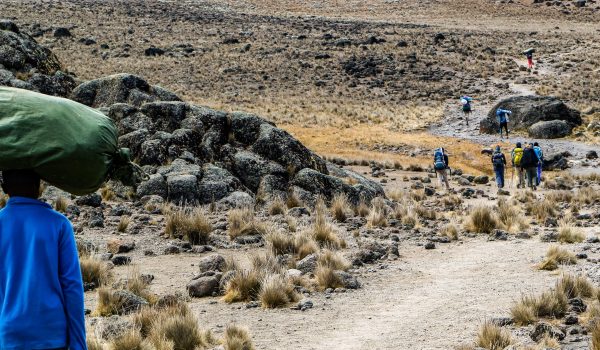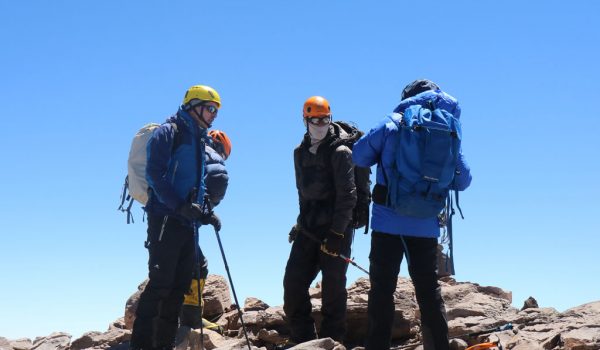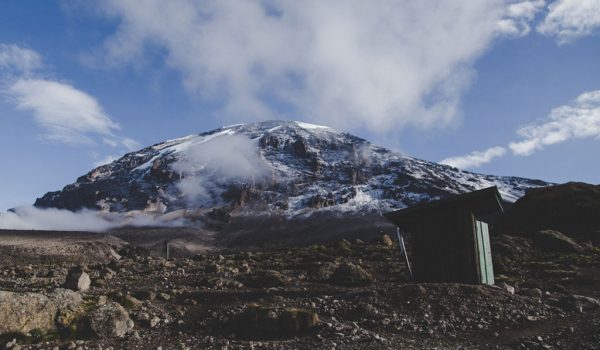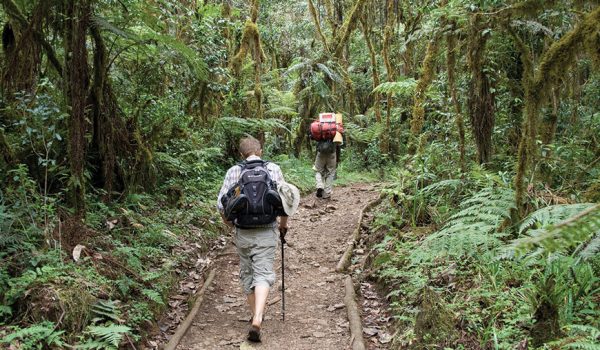It is also the tallest free-standing mountain in the world – meaning it is not part of a mountain range. Kilimanjaro is also unique as it is located just 330km from the equator. The mountain is composed of three distinct volcanic cones – Kibo (5,895m), Shira (3,962m), and Mawenzi (5,149m), with Kibo being the highest at Uhuru Peak. While Mawenzi and Shira are extinct, Kibo is dormant and could erupt again in the future.


With the assistance of our professional guide team, we can get you to the peak so that you can gaze out across Africa.
Our experienced mountain guides will ensure that your climb to the roof of Africa is as safe and easy as possible. They have an intimate knowledge of the various routes and the climate conditions, allowing them to predict changes and avoid accidents along the way.
At 100 kilometers in length and 60 kilometers in width, Mount Kilimanjaro has its own climate and five distinct vegetation zones. The climatic conditions on Mount Kilimanjaro change with the altitude; ranging from a tropical climate at its base to arctic conditions at the summit.
Kilimanjaro’s foothills enjoy a yearlong summer, with temperatures at the base averaging 25-30C year-round. Conversely, temperatures at the summit range from a chillier -10C to -20C. As a rule of thumb, the temperature drops by 1C for every 200m you ascend.
The mountain experiences two rainy seasons: the monsoon (or long rainy season) between March and May, and the short rainy season from mid-October until late December. At the base, the mountain has upwards of 2,000mm of rain per year, compared to just 100mm of rain at the summit.


The Farmland Zone (800 – 1,800 meters)
Characterized by vast fields of grass, the slopes between 800 and 1,800m receive plenty of rainfall. The Chagga people use this area for agriculture and livestock due to the rainfalls and the rich, volcanic soil. The locals primarily harvest coffee and bananas in this zone, although maize, beans, and other crops are also grown. The northern and eastern slopes are not as heavily cultivated, and so more native vegetation can be seen in these areas. There are no wild animals in the farmland zone, but you can still see lowland forest, bushland, wildflowers, and scrub.
Mountain Forest (1,800 – 2,800 meters)
Beginning at 1,800m, the mountain forest zone is the most fertile of all of Kilimanjaro’s vegetation zones. About 96% of Kilimanjaro’s rain falls in this zone, and so the region is extremely wet for most of the year. The thick vegetation is home to animals such as blue monkeys, elephants, black and white colobus monkeys, bush pigs, squirrels, duikers, elands, and even leopards; although these can be difficult to spot in the thick undergrowth. Unlike most East African mountain forests, Mount Kilimanjaro’s forests do not have bamboo trees. They do, however, have an impressive variety of birdlife.
Low Alpine Zone (2,800 to 3,800 metres)
Stretching from 2,800m to 3,800m, the low alpine zone has two overlapping vegetation types: heaths and the moorland. The misty heaths begin immediately above the treeline and experience cooler (around 0C or below) temperatures and fairly high rainfall (approximately 1300mm a year). Broad grassy fields dotted with wildflowers characterise this part of the low alpine zone, and animals such as elands, duikers, bushbucks, and buffalo can be seen here. Beautiful flora such as the yellow-flowered Protea, red-hot poker, Erica Arborea (tree heath), and a number of other plants unique to the area can also be seen. At approximately 3,200m, the moorlands begin. The air begins to thin at this point, making hiking more difficult and ensuring clear skies overhead. Despite these harsher conditions, it is still possible to see a variety of wildlife such as elephants, elands, klipspringers, and a variety of local rodents at this height. The giant Dendrosenecio Kilimanjari, unique to the mountain, dominates the plant-life in this zone.
The Alpine Zone (4,000 to 5,000 metres)
At around 4,000 metres the alpine zone begins. An area of alpine desert with sandy soil and harsh weather, it is here that the temperatures begin to have extreme variations that can jump between 40C during the day and below 0C by night. There are no permanent animal populations at this height, and plant life is limited to hardy flowers and mosses.
The Summit (5000+ metres)
At this height, there is only rock and ice. Only insects and the hardiest forms of lichen can exist in these harsh conditions. The summit has a number of glaciers, the most prominent of which is the Great Northern Glacier at Kibo’s northern face.